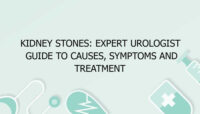Coronary Artery Disease (CAD), also known as coronary heart disease (CHD), is a condition that affects the coronary arteries, the blood vessels that supply oxygen-rich blood to the heart muscle. When these arteries become narrowed or blocked, the flow of oxygen and nutrients to the heart is reduced, which can lead to a variety of serious health issues, including chest pain (angina), heart attacks, heart failure, and even sudden death. CAD is one of the most common and dangerous heart conditions worldwide, with a significant impact on public health. It is a leading cause of morbidity and mortality, but the good news is that it can often be prevented and managed with proper lifestyle changes, medical treatment, and early detection.
In this article, we will explore the key aspects of coronary artery disease, from its causes and symptoms to its diagnosis, treatment, and prevention. Understanding the risks and symptoms of CAD is crucial because early intervention can significantly improve long-term health outcomes.
1. Causes of Coronary Artery Disease (CAD)
The primary cause of coronary artery disease is atherosclerosis, a condition in which plaque builds up on the walls of the coronary arteries. This plaque is made up of cholesterol, fatty deposits, calcium, and other cellular debris. Over time, the plaque hardens and narrows the arteries, restricting blood flow to the heart. As the arteries become more clogged, the risk of serious cardiovascular events increases.
Several factors contribute to the development of atherosclerosis and CAD, including:
- High cholesterol levels: An excess of low-density lipoprotein (LDL) cholesterol, or “bad cholesterol,” promotes plaque buildup in the arteries. On the other hand, high-density lipoprotein (HDL) cholesterol, or “good cholesterol,” helps remove plaque.
- High blood pressure: Chronic hypertension can damage the inner lining of the arteries, making them more susceptible to plaque accumulation.
- Smoking: Smoking accelerates the process of atherosclerosis by increasing cholesterol levels and causing inflammation in the arteries.
- Diabetes: High blood sugar levels contribute to plaque formation and can make the arteries less elastic and more prone to damage.
- Obesity: Excess body weight increases the risk of high blood pressure, high cholesterol, and diabetes, all of which contribute to CAD.
- Physical inactivity: A lack of exercise can raise the risk of obesity, high blood pressure, and high cholesterol, all of which are associated with CAD.
- Family history and genetics: A family history of heart disease can increase the likelihood of developing CAD. Inherited genetic factors can make individuals more susceptible to high cholesterol levels or high blood pressure.
- Age and gender: As people age, their arteries naturally become less flexible, and plaque buildup can accelerate. Men are at higher risk at a younger age, but women’s risk increases after menopause.
The combination of these factors leads to the progressive narrowing of the coronary arteries, restricting blood flow to the heart and increasing the likelihood of chest pain (angina) or a heart attack.
2. Symptoms of Coronary Artery Disease
In the early stages of coronary artery disease, symptoms may be mild or even nonexistent. Many people don’t experience noticeable symptoms until the disease has significantly progressed, which is why CAD is often called a “silent killer.” When symptoms do occur, they can vary depending on the severity of the blockage and the area of the heart affected. Some of the most common symptoms include:
- Chest pain (angina): The most classic symptom of CAD is chest pain or discomfort, often described as a squeezing, pressure-like sensation in the chest. Angina typically occurs with physical exertion or stress, and it may be relieved by rest.
- Shortness of breath: As the heart’s ability to pump blood decreases due to blocked arteries, individuals may experience difficulty breathing, especially during physical activity.
- Fatigue: Reduced blood flow to the heart can result in a feeling of exhaustion or weakness, even after minimal exertion.
- Dizziness or lightheadedness: If the heart is not pumping efficiently, it can cause low blood pressure, leading to dizziness, fainting, or a feeling of being lightheaded.
- Heart palpitations: People with CAD may experience irregular heartbeats, which can feel like fluttering or pounding in the chest.
- Pain radiating to other areas: In some cases, chest pain may radiate to the arms, neck, jaw, back, or stomach. This can be a warning sign of a heart attack.
It is important to note that the severity and frequency of symptoms can vary. Some people may only experience occasional angina during physical activity, while others may experience persistent chest pain or other symptoms even at rest. If any of these symptoms occur, it is crucial to seek medical attention immediately.
3. Diagnosis of Coronary Artery Disease
Diagnosing coronary artery disease involves a combination of physical exams, medical history reviews, blood tests, and imaging techniques. Because many of the symptoms of CAD are similar to those of other conditions, accurate diagnosis is essential. Common diagnostic tests for CAD include:
- Electrocardiogram (ECG or EKG): An ECG records the electrical activity of the heart and can identify abnormal heart rhythms, previous heart attacks, or signs of decreased blood flow to the heart.
- Stress test: During a stress test, the patient is asked to exercise (usually on a treadmill) while the heart is monitored. This test can help identify areas of the heart that are not receiving enough oxygen during physical exertion, which may indicate a blockage.
- Echocardiogram: This ultrasound-based test uses sound waves to create detailed images of the heart’s chambers and valves. It can help assess how well the heart is pumping blood and whether there are any structural issues, such as narrowed or damaged arteries.
- Coronary angiography (catheterization): This is the gold standard for diagnosing CAD. During the procedure, a thin tube (catheter) is inserted into a blood vessel, usually in the groin or arm, and threaded to the coronary arteries. A contrast dye is injected into the arteries to make them visible on an X-ray, allowing doctors to assess the location and severity of blockages.
- CT angiography: This non-invasive imaging technique uses a CT scanner to create detailed images of the coronary arteries, helping to detect blockages or plaque buildup.
Once a diagnosis is confirmed, the doctor will determine the severity of the disease and recommend a treatment plan tailored to the patient’s needs.
4. Treatment Options for Coronary Artery Disease
The treatment for coronary artery disease focuses on managing the symptoms, slowing the progression of the disease, and preventing complications such as heart attacks or heart failure. Treatment options can include:
Lifestyle Changes
- Diet: A heart-healthy diet rich in fruits, vegetables, whole grains, lean proteins, and healthy fats is essential. Reducing saturated fats, trans fats, and sodium intake can help manage cholesterol and blood pressure.
- Exercise: Regular physical activity is crucial for improving cardiovascular health, managing weight, and reducing the risk of heart disease.
- Weight management: Maintaining a healthy weight can reduce the strain on the heart and help control risk factors such as high blood pressure, diabetes, and high cholesterol.
- Smoking cessation: Quitting smoking is one of the most effective ways to reduce the risk of CAD and other cardiovascular diseases.
- Stress management: Reducing stress through relaxation techniques such as yoga, meditation, and deep breathing can help lower blood pressure and improve heart health.
Medications
- Statins: These medications help lower cholesterol levels, reducing plaque buildup in the arteries and slowing the progression of CAD.
- Aspirin: Aspirin can help prevent blood clots from forming, reducing the risk of heart attacks.
- Beta-blockers: These medications lower blood pressure and reduce the workload on the heart.
- ACE inhibitors: These medications help relax blood vessels and reduce blood pressure.
- Calcium channel blockers: These drugs help relax and widen the blood vessels, making it easier for the heart to pump blood.
Procedures and Surgery
- Angioplasty: In this procedure, a balloon is inflated inside a narrowed artery to widen it and restore blood flow. A stent (a small mesh tube) may also be inserted to keep the artery open.
- Coronary artery bypass surgery (CABG): In cases of severe CAD, bypass surgery may be needed to create new pathways for blood to flow around blocked arteries.
- Heart transplant: In rare cases, when the heart is severely damaged and other treatments are not effective, a heart transplant may be necessary.
5. Prevention of Coronary Artery Disease
Preventing coronary artery disease involves adopting a heart-healthy lifestyle and managing risk factors effectively. Key steps to prevent CAD include:
- Eating a balanced diet: A diet rich in nutrients and low in unhealthy fats can prevent plaque buildup in the arteries.
- Regular exercise: Engaging in physical activity for at least 150 minutes a week can help keep the heart healthy.
- Avoiding tobacco: Quitting smoking reduces the risk of CAD and helps improve overall heart health.
- Controlling blood pressure and cholesterol: Regular monitoring and treatment for high blood pressure and high cholesterol are critical in reducing the risk of CAD.
- Managing diabetes: Keeping blood sugar levels under control can prevent the development of CAD in individuals with diabetes.
- Maintaining a healthy weight: Achieving and maintaining a healthy weight reduces the strain on the heart and lowers the risk of heart disease.
Table: Key Factors in Coronary Artery Disease
| Risk Factor | Impact on Coronary Artery Disease |
|---|---|
| High cholesterol | Promotes plaque buildup in the arteries, narrowing blood vessels. |
| High blood pressure | Damages the artery walls, making them more prone to plaque formation. |
| Smoking | Increases cholesterol levels and causes inflammation in the arteries. |
| Obesity | Contributes to high cholesterol, blood pressure, and diabetes. |
| Physical inactivity | Increases the risk of obesity, high blood pressure, and high cholesterol. |
Frequently Asked Questions (FAQs) About Coronary Artery Disease
1. What are the early signs of coronary artery disease?
In the early stages of coronary artery disease (CAD), many people do not experience noticeable symptoms. However, when symptoms do appear, they may include chest pain (angina), shortness of breath, fatigue, dizziness, or palpitations. These symptoms may occur during physical activity or stress, as the heart requires more oxygen when exerted. If you experience any of these signs, it’s important to seek medical attention to determine whether CAD is the cause.
2. How is coronary artery disease treated without surgery?
Many people with coronary artery disease (CAD) can manage their condition without surgery. Treatment typically focuses on medications to control blood pressure, lower cholesterol, and reduce the risk of blood clots. Lifestyle changes, such as adopting a heart-healthy diet, quitting smoking, exercising regularly, and managing stress, are also essential in controlling the progression of the disease. Medications like statins, beta-blockers, and aspirin can help manage symptoms and prevent complications.
3. Is coronary artery disease reversible?
While coronary artery disease cannot be completely reversed, its progression can be slowed or stopped with the right treatment and lifestyle changes. Medications, combined with dietary modifications, exercise, and smoking cessation, can significantly improve heart health and prevent further damage to the arteries. In some cases, angioplasty or bypass surgery may be required to restore blood flow. The earlier CAD is detected, the better the chances for effective treatment and management.
4. What lifestyle changes are most effective for preventing coronary artery disease?
The most effective lifestyle changes for preventing coronary artery disease include adopting a heart-healthy diet, exercising regularly, quitting smoking, and managing risk factors like high blood pressure, high cholesterol, and diabetes. A diet rich in fruits, vegetables, whole grains, lean proteins, and healthy fats can help reduce plaque buildup in the arteries. Regular exercise can improve cardiovascular health, manage weight, and reduce the risk of other conditions like high blood pressure.


